Related Research Articles

Cogito, ergo sum is a philosophical statement that was made in Latin by René Descartes, usually translated into English as "I think, therefore I am". The phrase originally appeared in French as je pense, donc je suis in his Discourse on the Method, so as to reach a wider audience than Latin would have allowed. It appeared in Latin in his later Principles of Philosophy. As Descartes explained it, "we cannot doubt of our existence while we doubt." A fuller version, articulated by Antoine Léonard Thomas, aptly captures Descartes's intent: dubito, ergo cogito, ergo sum. The dictum is also sometimes referred to as the cogito.
Hiragana is a Japanese syllabary, one component of the Japanese writing system, along with katakana, kanji and in some cases Latin script. It is a phonetic lettering system. The word hiragana literally means "ordinary" or "simple" kana.

In philosophy, idealism is a diverse group of metaphysical views which all assert that "reality" is in some way indistinguishable or inseparable from human perception and/or understanding, that it is in some sense mentally constructed, or that it is otherwise closely connected to ideas. In contemporary scholarship, traditional idealist views are generally divided into two groups. Subjective idealism takes as its starting point that objects only exist to the extent that they are perceived by someone. Objective idealism posits the existence of an objective consciousness which exists before and, in some sense, independently of human consciousness, thereby bringing about the existence of objects independently of human minds. In the early modern period, George Berkeley was often considered the paradigmatic idealist, as he asserted that the essence of objects is to be perceived. By contrast, Immanuel Kant, a pioneer of modern idealist thought, held that his version of idealism does “not concern the existence of things”, but asserts only that our “modes of representation” of them, above all space and time, are not “determinations that belong to things in themselves” but essential features of our own minds. Kant called this position “transcendental idealism”, holding that the objects of experience relied for their existence on the mind, and that the way that things in themselves are outside of our experience cannot be thought without applying the categories which structure all of our experiences. However, since Kant's view affirms the existence of some things independently of experience, it is very different from the more traditional idealism of Berkeley.

Marie-Esprit-Léon Walras was a French mathematical economist and Georgist. He formulated the marginal theory of value and pioneered the development of general equilibrium theory. Walras is best known for his book Éléments d'économie politique pure, a work that has contributed greatly to the mathematization of economics through the concept of general equilibrium. The definition of the role of the entrepreneur found in it was also taken up and amplified by Schumpeter.
The concept of an archetype appears in areas relating to behavior, historical psychology, and literary analysis. An archetype can be:
- a statement, pattern of behavior, prototype, "first" form, or a main model that other statements, patterns of behavior, and objects copy, emulate, or "merge" into. Informal synonyms frequently used for this definition include "standard example," "basic example," and the longer-form "archetypal example;" mathematical archetypes often appear as "canonical examples."
- the Platonic concept of pure form, believed to embody the fundamental characteristics of a thing.
- a collectively-inherited unconscious idea, pattern of thought, image, etc., that is universally present, in individual psyches, as in Jungian psychology
- a constantly-recurring symbol or motif in literature, painting, or mythology. This definition refers to the recurrence of characters or ideas sharing similar traits throughout various, seemingly unrelated cases in classic storytelling, media, etc. This usage of the term draws from both comparative anthropology and from Jungian archetypal theory.
In philosophy, a noumenon is a posited object or event that exists independently of human sense and/or perception. The term noumenon is generally used in contrast with, or in relation to, the term phenomenon, which refers to any object of the senses. Immanuel Kant first developed the notion of the noumenon as part of his transcendental idealism, suggesting that while we know the noumenal world to exist because human sensibility is merely receptive, it is not itself sensible and must therefore remain otherwise unknowable to us. In Kantian philosophy, the unknowable noumenon is often identified with or associated with the unknowable "thing-in-itself". However, the nature of the relationship between the two is not made explicit in Kant's work, and remains a subject of debate among Kant scholars as a result.

Pure Land Buddhism, also referred to as Amidism in English, is a broad branch of Mahayana Buddhism and one of the most widely practiced traditions of Buddhism in East Asia. Pure Land is a tradition of Buddhist teachings that are focused on the Buddha Amitābha. The three primary texts of the tradition, known as the "Three Pure Land Sutras", are the Longer Sukhāvatīvyūha Sūtra, Amitayurdhyana Sutra and the Shorter Sukhāvatīvyūha Sūtra.
Henry Watson Fowler was an English schoolmaster, lexicographer and commentator on the usage of the English language. He is notable for both A Dictionary of Modern English Usage and his work on the Concise Oxford Dictionary, and was described by The Times as "a lexicographical genius".

Critique of Pure Reason is a book by the German philosopher Immanuel Kant, in which the author seeks to determine the limits and scope of metaphysics. Also referred to as Kant's "First Critique", it was followed by his Critique of Practical Reason (1788) and Critique of Judgment (1790). In the preface to the first edition, Kant explains that by a "critique of pure reason" he means a critique "of the faculty of reason in general, in respect of all knowledge after which it may strive independently of all experience" and that he aims to reach a decision about "the possibility or impossibility of metaphysics."

RAS syndrome is the use of one or more of the words that make up an acronym in conjunction with the abbreviated form. This means, in effect, repeating one or more words from the acronym. Three common examples are "PIN number" / "VIN number" and "ATM machine". The term RAS syndrome was coined in 2001 in a light-hearted column in New Scientist.
Apatheism is the attitude of apathy towards the existence or non-existence of God(s). It is more of an attitude rather than a belief, claim, or belief system. The term was coined by Robert Nash in 2001.

Giovanni Gentile was an Italian neo-Hegelian idealist philosopher, educator, and fascist politician. The self-styled "philosopher of Fascism", he was influential in providing an intellectual foundation for Italian Fascism, and ghostwrote part of The Doctrine of Fascism (1932) with Benito Mussolini. He was involved in the resurgence of Hegelian idealism in Italian philosophy and also devised his own system of thought, which he called "actual idealism" or "actualism", which has been described as "the subjective extreme of the idealist tradition".

Actual idealism was a form of idealism, developed by Giovanni Gentile, that grew into a 'grounded' idealism, contrasting the transcendental idealism of Immanuel Kant, and the absolute idealism of G. W. F. Hegel. To Gentile, who considered himself the "philosopher of fascism," actualism was the sole remedy to philosophically preserving free agency, by making the act of thinking self-creative and, therefore, without any contingency and not in the potency of any other fact.

In common usage, a physical object or physical body is a collection of matter within a defined contiguous boundary in three-dimensional space. The boundary must be defined and identified by the properties of the material. The boundary may change over time. The boundary is usually the visible or tangible surface of the object. The matter in the object is constrained to move as one object. The boundary may move in space relative to other objects that it is not attached to. An object's boundary may also deform and change over time in other ways.

Prolegomena to Any Future Metaphysics That Will Be Able to Present Itself as a Science is a book by the German philosopher Immanuel Kant, published in 1783, two years after the first edition of his Critique of Pure Reason. One of Kant's shorter works, it contains a summary of the Critique‘s main conclusions, sometimes by arguments Kant had not used in the Critique. Kant characterizes his more accessible approach here as an "analytic" one, as opposed to the Critique‘s "synthetic" examination of successive faculties of the mind and their principles.

In the United States, the meaning of "village" varies by geographic area and legal jurisdiction. In many areas, "village" is a term, sometimes informal, for a type of administrative division at the local government level. Since the Tenth Amendment to the United States Constitution prohibits the federal government from legislating on local government, the states are free to have political subdivisions called "villages" or not to and to define the word in many ways. Typically, a village is a type of municipality, although it can also be a special district or an unincorporated area. It may or may not be recognized for governmental purposes.

A chemical substance is a form of matter having constant chemical composition and characteristic properties. Some references add that chemical substance cannot be separated into its constituent elements by physical separation methods, i.e., without breaking chemical bonds. Chemical substances can be simple substances, chemical compounds, or alloys. Chemical elements may or may not be included in the definition, depending on expert viewpoint.
Xuanxue is a metaphysical post-classical Chinese philosophy from the Six Dynasties (222-589), bringing together Taoist and Confucian beliefs through revision and discussion. The movement found its scriptural support both in Taoist and drastically-reinterpreted Confucian sources. Xuanxue, or "Mystic Learning”, came to reign supreme in cultural circles, especially at Jiankang during the period of division. The concept represented the more abstract, unworldly, and idealistic tendency in early medieval Chinese thought. Xuanxue philosophers combined elements of Confucianism and Taoism to reinterpret the I Ching, Tao Te Ching and Zhuangzi.
In chemistry, the mass concentrationρi is defined as the mass of a constituent mi divided by the volume of the mixture V.
Bhrama, in the context of Hindu thought, means – error, mistake, illusion, confusion, perplexity. But, it literally means – that which is not steady; and refers to error etc., caused by defects in the perceptive system. The seeing of snake in a rope in darkness, silver nacre in moonlight, water in a mirage on a hot day and a person in a stump of tree are four classic instances quoted in Vedantic texts. Bhrama is a mistake, it is a confusion about one object which exists for another object which does not exist, it merely refers to the fallibility of human perception.
References
- ↑ Mind: A Quarterly Review of Psychology and Philosophy, : Vol. 105, issue 417 (Jan. 1996)
- ↑ Treatise on Logic (1895)
- ↑ The Thought that Counts, Paul Davies, New Scientist, 6 May 1995